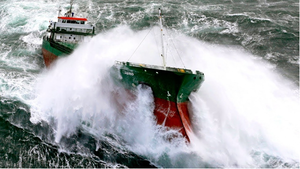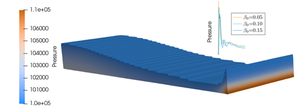Numerical modelling of aerated extreme wave impacts

 Background
Background
The severity of the waves is increasing, leading to higher design loads for sea-going vessels and offshore structures. Hydrodynamic impact loading due to slamming, breaking waves and green water account for 10% of structural damage for conventional ships. During these complex free-surface events, air and water interact through biological processes, capillary entrapment, white capping and wave breaking. This leads to entrained air, persisting for many wave periods.
Main objective
To develop a numerical method for wave impacts with entrained air on maritime structures.
First results
Current methods to predict forces in wave impacts assume that the fluid is incompressible. However, the air drastically modifies the compressibility of the fluid up to several orders of magnitude, making the compressibility of air inevitable in the impact process and the contemporary methods inadequate. The relevance of the local physical processes due to aeration is researched.
Based on the method ComFLOW, a start was made by including an extra volume fraction to indicate the amount of air in water. In combination with fluid-structure interaction, incorporation of aeration will yield an adequate method for violent free-surface wave interaction events with structures. The first results with the method are for a dambreak hitting a wall. It was found that more aeration leads to lower, but long pressure peaks in an impact and subsequent pressure oscillations.
Participants
- Martin van der Eijk
- Dr.Ir. Peter Wellens